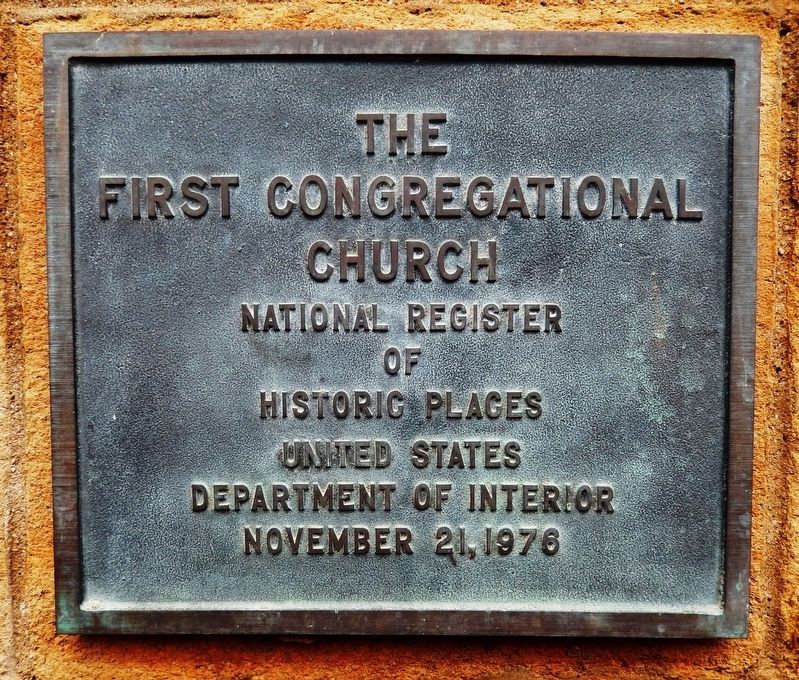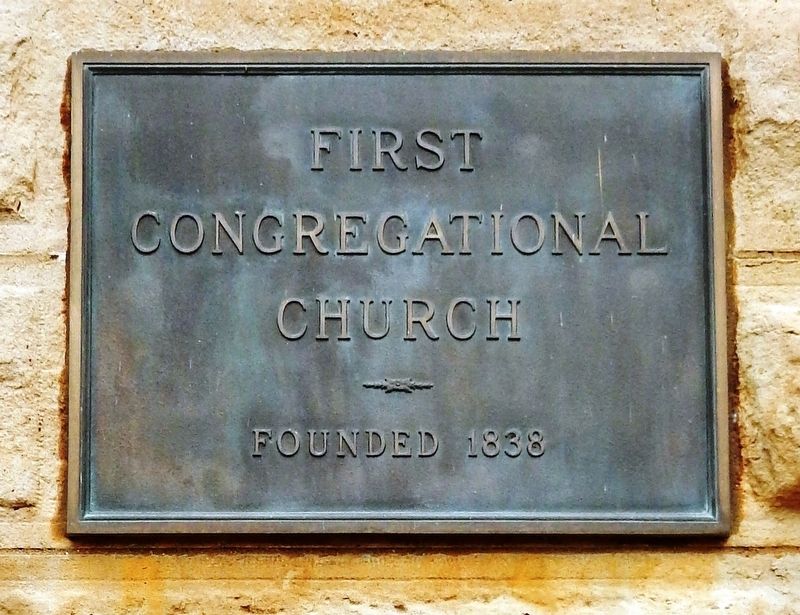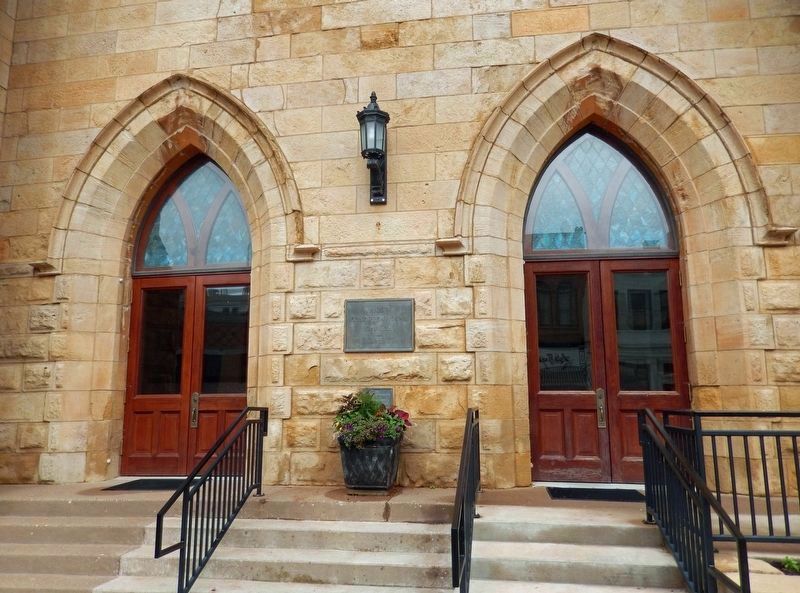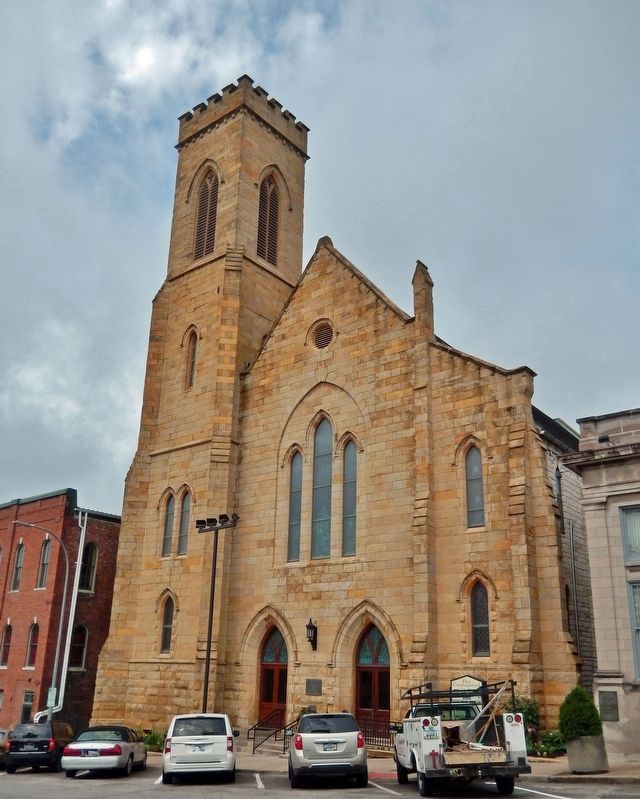Burlington in Des Moines County, Iowa — The American Midwest (Upper Plains)
The First Congregational Church
of
Historic Places
United States
Department of the Interior
November 21, 1976
Topics and series. This historical marker is listed in these topic lists: Abolition & Underground RR • Architecture • Churches & Religion • Notable Buildings. In addition, it is included in the National Register of Historic Places series list. A significant historical year for this entry is 1860.
Location. 40° 48.638′ N, 91° 6.24′ W. Marker is in Burlington, Iowa, in Des Moines County. Marker is on North 4th Street just north of Jefferson Street, on the left when traveling north. The marker is mounted at waist-level, directly on the subject building, between the two front entryways. Touch for map. Marker is at or near this postal address: 313 North 4th Street, Burlington IA 52601, United States of America. Touch for directions.
Other nearby markers. At least 8 other markers are within 10 miles of this marker, measured as the crow flies. First Civil War Monument West of the Mississippi (within shouting distance of this marker); 20th Anniversary of the Snake Alley Criterium (within shouting distance of this marker); Hedge's Building (within shouting distance of this marker); Hotel Burlington (about 600 feet away, measured in a direct line); The Burlington Public Library (about 600 feet away); Snake Alley (about 600 feet away); Engine No. 3003 / Market Square (approx. ¼ mile away); Henderson County Covered Bridge (approx. 9.9 miles away in Illinois). Touch for a list and map of all markers in Burlington.
Regarding The First Congregational Church. National Register of Historic Places #76000763. Also a contributing property in Heritage Hill Historic District (NRHP #82000406).
From the National Register Nomination:
The First Congregational Church is built of dressed dolomite in Gothic Revival style. Its primary feature is a square, crenelated tower, whose three stages are separated by beltlines. Buttresses reach the top of the second stage on three corners. There are lancet openings on all three stages, those at the top being covered with louvres. Windows in the main structure are similarly shaped, and filled with stained glass. A triptych of stained glass is above the two pointed-arched entries. Buttresses decorate the corners and side walls.
Beyond its pleasing architecture, this church is significant as the church of William Salter (1821-1910), who served this congregation for 64 years. Salter came to Iowa in 1843 as one of the Iowa Band of Congregational missionaries whose efforts in frontier Iowa were to have a lasting impact upon the religious history of the state. He became pastor at Burlington in 1846, and over 64 years, became a figure of importance not only in religious circles, but in the fields of education and history as well. A religious activist, Salter assisted the "underground railroad" in Iowa, and is said to have sheltered runaway slaves in a room beneath his church.
Also see . . .
1. First Congregational Church (Wikipedia). Excerpt:
The congregation was organized in 1838. The Rev. Horace Hutchinson was the first pastor and the congregation met in the home of James G. Edwards who was the publisher of the Burlington Hawk-Eye. He was succeeded by the Rev. William Salter who served here for 64 years (1846-1910). The congregation was involved in social ministry, civil rights, public education, and free libraries. Under Salter's leadership, it was a champion of the abolition of slavery and was a stop on the Underground Railroad. This church building was constructed from 1867 to 1870.(Submitted on December 29, 2023, by Cosmos Mariner of Cape Canaveral, Florida.)
2. Heritage Hill Historic District (Wikipedia). Excerpt:
The Heritage Hill Historic District is primarily a residential neighborhood on the hill north of the central business district. Several churches act as a buffer and provide a transition from the residential area and the commercial areas in the valley.(Submitted on December 29, 2023, by Cosmos Mariner of Cape Canaveral, Florida.)
Credits. This page was last revised on December 29, 2023. It was originally submitted on December 29, 2023, by Cosmos Mariner of Cape Canaveral, Florida. This page has been viewed 56 times since then and 15 times this year. Photos: 1, 2, 3, 4. submitted on December 29, 2023, by Cosmos Mariner of Cape Canaveral, Florida.



